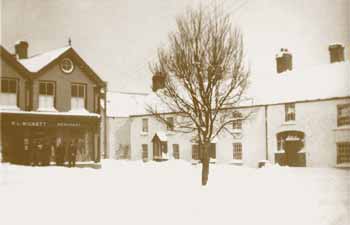Meteorological Station
Since the early 1960's the Meteorological Station at Bradworthy has supplied records, principally of rainfall, to the Meteorological Office.
Devon and the West Country was visited by a blizzard of an intensity comparable to the snowstorms of 1908 and the Great Blizzard of the 1890's.
A week later a high wind swept the snow from the fields into immense drifts.
Sleet came with the wind and frost followed.
On Sunday morning one was surprised to find it possible to walk quite comfortably in places, over solid snow six or seven feet in depth.
To remove it from doorways and paths one had to split it out like blocks of salt. (January 1947)
In addition, other weather events have been recorded for future study by the Rev. C.G. Greathead Montgomery.
At least two members of the farming community (of Bradworthy) have been overcome by cold during their outdoor duties. Fortunately, both recovered. (March 1947)
Due to its position with an average height above sea level of 500 feet, Bradworthy enjoys very special weather patterns.
Sheep and Poultry Frozen
During last week's exceptional weather, farmers had an anxious time, and there were cases where sheep and poultry were frozen where they stood.
Nearly all telegraph wires were down and trailing across roads, hedges and fields, and the poles and large limbsa of trees also snapped under the weight of ice.
Electricity was cut off and householders had to resort to paraffin lamps and candles for light.
Hammers were needed to open gates and doors, and some locks and fasteners would only respond to boiling water.
The countryside presented an amazing spectacle and Thursday's bright sunlight lent an unsurpassed brilliance to the landscape. (March 1947)
As the moisture laden Atlantic winds are lifted up they become cooled and deposit rain upon the area, giving it a yearly average of 53.2 inches.
The driest year recorded was 1976 with 40.38 inches only, while the wettest was 1974 with an all time record for this area of 64.80 inches (the next wettest was 1994 with 64.5 inches). Thunderstorms are comparatively rare.
Sleigh Transport at Bradworthy
The isolation of Bradworthy and neighbouring villages and hamlets called for some unique improvisation in transport at the week-end.
Cut off by miles of snow-blocked roads from the towns, sleighs big and small were resorted to.
Farmers faced with great difficulties for days, regarding the hold-up of their milk, were transporting their churns by sleigh on Saturday, to
a central place for collection.
A bulldozer worked in the neighbourhood throughout Friday night, and cleared a number of roads.
With the aid of a lorry, three days mail was delivered to Bradworthy Post Office on Saturday.
Even then, some outlying sub-post offices could not be reached by wheeled vehicle, and the mail bags were carried to them on foot
over the last stages of the journey.
Postmen were trudging round to remote farms and cottages until dark, and the older men declared they had never seen the lanes so snow-logged
in all their experience of carrying H.M. mails.
On Saturday night a high wind swept the snow from the fields into immense drifts.
Sleet came with the wind and frost followed. On Sunday morning one was surprised to find it possible to walk quite comfortably in places,
over solid snow six or seven feet in depth.
To remove it from doorways and paths, one had to split it out like blocks of salt.
We have heard old people recount stories of days when they walked over snow on a level with the tops of the hedges.
This year we have again had that same rare experience. (February 1947)
Strong gales occurred on St. Paul's day, January 25th 1990 when winds of over 70 miles per hour were recorded.
Holsworthy awoke to a scene of fantastic beauty. Rain, for a day and night previously, had frozen as it fell, and had encased every twig of every tree, every lovely shrub and blade of grass in a coating of ice, so that all looked as if made of glass. (March 1947)
The winters of 1947, 1963 and 1978 were extremely severe with either exceptional snowfalls or very low temperatures.
The wonderful display of the Aurora Borealis, or 'Northern Lights' on Tuesday evening was watched with great interest by villagers.
To the residents on the west and north of the parish where the land is very high a remarkable sight was afforded.
The western sky was curtained in a deep rosy glow, and on the east the colour was only a little less brilliant.
On the northern horizon sheets of light, like that shed by the moon, surged upwards, and were shot through by shafts of white, pale green and pink
piercing the heavens like the beams of a searchlight.
The rare phenomenon lasted for two hours, and throughout the greater part of the night afterwards, the sky seemed to be illuminated, as though the
sun or the moon were just rising.
I spoke to several people of the older generation in Bradworthy and they were unanimous in declaring that they had never seen such a grand
display of the 'Northern Lights' before. (February 1938)

